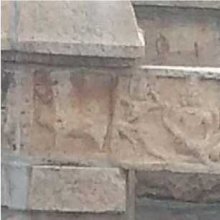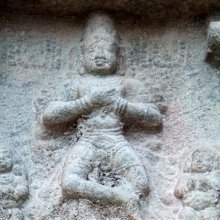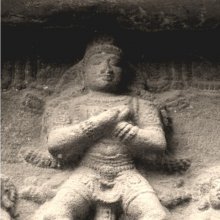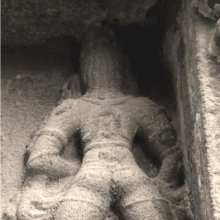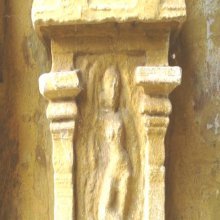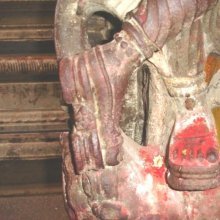Svastika, Su-astika: 32 definitions
Introduction:
Svastika means something in Buddhism, Pali, Hinduism, Sanskrit, Jainism, Prakrit, the history of ancient India, Marathi, Hindi, biology. If you want to know the exact meaning, history, etymology or English translation of this term then check out the descriptions on this page. Add your comment or reference to a book if you want to contribute to this summary article.
Alternative spellings of this word include Swastik.
Images (photo gallery)
(+46 more images available)
In Hinduism
Natyashastra (theatrics and dramaturgy)
Source: Wisdom Library: Nāṭya-śāstra1a) Svastika (स्वस्तिक).—One of the 108 karaṇas (minor dance movement) mentioned in the Nāṭyaśāstra chapter 4. The instructions for this svastika-karaṇa is as follows, “hands and feet respectively held together in the Svastika form.”. A karaṇa represents a minor dance movements and combines sthāna (standing position), cārī (foot and leg movement) and nṛttahasta (hands in dancing position).
1b) Svastika also refers to a gesture (āṅgika) made with ‘combined hands’ (saṃyuta), according to the Nāṭyaśāstra chapter 8. Svastika is also the name for a type of gesture (āṅgika) made with ‘dance hands’ (nṛttahasta). (Instructions): Two arāla or vardhamāna hands upturned and held together at the wrists on the left side will form the svastika. It is to be used by women. (Uses): When the hands are separated from the svastika position, it will indicate directions, clouds, the sky, forests, seas, seasons, the earth and similar other extensive things.
The hands (hasta) form a part of the human body which represents one of the six major limbs (aṅga) used in dramatic performance. With these limbs are made the various gestures (āṅgika), which form a part of the histrionic representation (abhinaya).
1c) Svastika als refers to a type of gesture (āṅgika) made with dance-hands (nṛttahasta);—(Instructions): The talamukha hands crossed at the wrists; but released after this they are called viprakīrṇa. The dance-hands are to be used in forming karaṇas.
1d) Svastika also refers to a specific gesture (āṅgika) , or “movements made with the arms (bāhu)”, according to the Nāṭyaśāstra chapter 9. These movements form a part of the histrionic representation (abhinaya).
Source: archive.org: The mirror of gesture (abhinaya-darpana)1) One of the saṃyutta-hastāni (Twenty-four combined Hands).—Svastika (crossed): two Patāka hands held together at the wrists. Usage: crocodile, timid speech, dispute, praising.
2) One of the saṃyutta-hastāni (Twenty-six combined Hands).—Svastika (crossed): Tripatāka hands crossed on the left side. Patron deity Guha. Usage: Wishing-tree, mountains.
Source: Shodhganga: The significance of the mūla-beras (natya)1) Svastika means to “keep hand and leg svastika like nagabandham” and is one of the sixteen aṅgakiriyai (usage of the action of the body), which itself forms a division of Abhinaya or Avinaya (artistic expressions) as defined in the second book of the Pañcamarapu (‘five-fold traditional usage’) which represents an important piece of Tamil literature.—The Pañcamarapu (“five-fold traditional usage”) refers to a book on five established literary usages (five-fold traditional usages) defines terms such as Svastika. It was composed by Cerai Aṟivanār in the 9th century AD during the time of Pandyan Tirumaran of the last Caṅkam Period.
2) Svastika (स्वस्तिक) refers to one of the nine maṇḍala (postures of the feet) which represents one of the four “movements of the feet” (pāda) according to the Abhinayadarpaṇa. Svastika-maṇḍala is standing with the right foot put across the left foot and the right hand put across the left hand. This is the same in iconography also, but is labeled as svastikāsana. In iconography the legs are crossed in seated posture.
Source: Shodhganga: Elements of Art and Architecture in the Trtiyakhanda of the Visnudharmottarapurana (natya)1) Svastika (स्वस्तिक) refers to one of the thirteen Saṃyuktahastas or “combined hand gestures” (in Indian Dramas), according to the Viṣṇudharmottarapurāṇa, an ancient Sanskrit text which (being encyclopedic in nature) deals with a variety of cultural topics such as arts, architecture, music, grammar and astronomy.—The hasta-mudrās (lit. “hand-gestures”) are very essential to denote some particular action or state in dancing and these mudrās are formed with the help of hands and fingers.—In Sanskrit the word svastika denotes spiritual things. According to the Viṣṇudharmottarapurāṇa, in svastika-hasta, both hands are kept in arāla-hasta. In this posture, the palm should be upward and lying on twisted sides and kept on the wrists. This kind of hastamudrā is used to show something which is widely spread, seasons, sky, cloud, sea and the earth.
2) Svastika (स्वस्तिक) also refers to one of the thirty Nṛttahastas or “dance hand gestures”.—In the Viṣṇudharmottarapurāṇa, thirty kinds of nṛttahastas (“dance-hand gestures”) are mentioned. e.g., svastika. The practice of these nṛttahastas is strictly prohibited in sickness of body, in old age, in fear, drunk and anxiety.
3) Svastika (स्वस्तिक) refers to one of the 108 kinds of Karaṇa (“coordination of precise movements of legs and hands”), according to the Viṣṇudharmottarapurāṇa.—Accordingly, karaṇas are the coordination of precise movements of legs and hands performed in a particular posture. The Nāṭyaśāstra also gives its view point in the same spirit. In the Viṣṇudharmottarapurāṇa, one hundred and eight kinds of karaṇas are accepted, e.g., Svastika.

Natyashastra (नाट्यशास्त्र, nāṭyaśāstra) refers to both the ancient Indian tradition (shastra) of performing arts, (natya—theatrics, drama, dance, music), as well as the name of a Sanskrit work dealing with these subjects. It also teaches the rules for composing Dramatic plays (nataka), construction and performance of Theater, and Poetic works (kavya).
Vastushastra (architecture)
Source: Wisdom Library: Vāstu-śāstra1) Svastika (स्वस्तिक):—One of the eight types of villages, according to Chapter 9 of the Mānasāra (called the grāmalakṣaṇam). The Mānasāra is one of the traditional authorative Hindu treatises on Vāstuśāstra. The form of this village is said to be tattadrūpeṇa, which means it represents the form of the meaning of its Sanskrit name.
2) Svastika (स्वस्तिक) refers to a type of temple (prāsāda) classified under the group named Vairāja, according to Samarāṅgaṇasūtradhāra chapter 49. The Vairāja group contains twenty-four out of a sixty-four total prāsādas (temples) classified under five prime vimānas (aerial car/palace), which were created by Brahmā for as many gods (including himself). The group represents temples (e.g. Svastika) that are to be square shaped. The prāsādas, or ‘temples’, represent the dwelling place of God and are to be built in towns. The Samarāṅgaṇasūtradhāra is an 11th-century encyclopedia dealing with various topics from the Vāstuśāstra.
Svastika is mentioned in another list from the Samarāṅgaṇasūtradhāra chapter 56, being part of the group named Lalita, containing 25 unique temple varieties.
Svastika is also mentioned as a classification of ‘temple’ in the Īśānaśivagurudevapaddhati which features a list of 52 temple types. This list represents the classification of temples in South-India.
Svastika is also listed in the Agnipurāṇa which features a list of 45 temple types. It is listed under the group named Triviṣṭapa, featuring octagonal-shaped temples. This list represents a classification of temples in Nort-India.
3) Svastika (स्वस्तिक) refers to a variety of prāsāda (‘superstructure’, or, upper storey of any building), according to the Mayamata (5th-century guidebook on Dravidian architecture).
The Svastika variety in the Divatala (‘two-storey’) group has the following decorative components:
Number of talas (levels): 2;
Shape of grīva (neck) and śikhara (head): Square;
Number of śālas: 4;
Number of kūṭas: 4;
Number of pañajaras: 8;
Number of alpanāsis: 48;
Number of mahānāsis: 4;
The Svastika variety in the Tritala (‘three-storey’) group has the following decorative components:
Number of talas (levels): 3;
Shape of grīva (neck) and śikhara (head): Square;
Number of śālas: 8;
Number of kūṭas: 8;
Number of pañjaras: 8;
Number of alpanāsis: 96;
4) Svastika (स्वस्तिक) also refers to a category of gopura, which is the “tower” built above the gateway of a house, palace or Buddhist monastery.

Vastushastra (वास्तुशास्त्र, vāstuśāstra) refers to the ancient Indian science (shastra) of architecture (vastu), dealing with topics such architecture, sculpture, town-building, fort building and various other constructions. Vastu also deals with the philosophy of the architectural relation with the cosmic universe.
Purana and Itihasa (epic history)
Source: archive.org: Puranic Encyclopedia1) Svastika (स्वस्तिक).—A nāga (serpent) who lived in Girivraja. It is mentioned in Mahābhārata, Sabhā Parva, Chapter 9, Verse 9, that this serpent lives in the palace of Varuṇa.
2) Svastika (स्वस्तिक).—A warrior of Subrahmaṇya. (Mahābhārata Śalya Parva, Chapter 45, Verse 65).
Source: Cologne Digital Sanskrit Dictionaries: The Purana IndexSvastika (स्वस्तिक).—A Nāga in the fifth talam or mahātalam.*
- * Brahmāṇḍa-purāṇa II. 20. 37; Vāyu-purāṇa 50. 36.

The Purana (पुराण, purāṇas) refers to Sanskrit literature preserving ancient India’s vast cultural history, including historical legends, religious ceremonies, various arts and sciences. The eighteen mahapuranas total over 400,000 shlokas (metrical couplets) and date to at least several centuries BCE.
Ayurveda (science of life)
Nighantu (Synonyms and Characteristics of Drugs and technical terms)
Source: WorldCat: Rāj nighaṇṭuSvastika (स्वस्तिक) is another name for Śitāvarī, an unidentified medicinal plant, according to verse 4.50-52 of the 13th-century Raj Nighantu or Rājanighaṇṭu. The fourth chapter (śatāhvādi-varga) of this book enumerates eighty varieties of small plants (pṛthu-kṣupa). Note: Dr. J.K. Ojhā identifies Śitāvarī as Celosia argentea Linn (“plumed cockscomb”; of the Amaranthaceae family) while the commentator of the Rājanighaṇṭu identifies it with Blepharis edulis Pers (“uttanjan”; from the Acanthaceae family); both are quite apart from each other. Together with the names Svastika and Śitāvarī, there are a total of fifteen Sanskrit synonyms identified for this plant.
Veterinary Medicine (The study and treatment of Animals)
Source: Shodhganga: Portrayal of Animal Kingdom (Tiryaks) in Epics An Analytical study1) Svastika (स्वस्तिक) (lit. “an auspicious bird”) is a synonym (another name) for the Kukkuṭa, according to scientific texts such as the Mṛgapakṣiśāstra (Mriga-pakshi-shastra) or “the ancient Indian science of animals and birds” by Hamsadeva, containing the varieties and descriptions of the animals and birds seen in the Sanskrit Epics such as the Ramayana and Mahabharata.
2) Svastika (स्वस्तिक) (lit. “one who is auspicious, holy”) also refers to the Blue jay (Cāṣa).
Unclassified Ayurveda definitions
Source: Knowledge Traditions & Practices of India: Agriculture: A SurveySvastika (स्वस्तिक) refers to a “design of religious significance” and represents one of the layout designs for gardens and orchards mentioned in the Vṛkṣāyurveda: a Sanskrit text by written by Surapāla that deals with agriculture (kṛṣi).—Surapāla’s text mentions 170 species of plants including trees, shrubs and a few herbs, and deals with the laying out gardens and orchards and growing unusual trees. Layouts included designs such as svastika.

Āyurveda (आयुर्वेद, ayurveda) is a branch of Indian science dealing with medicine, herbalism, taxology, anatomy, surgery, alchemy and related topics. Traditional practice of Āyurveda in ancient India dates back to at least the first millenium BC. Literature is commonly written in Sanskrit using various poetic metres.
Shaivism (Shaiva philosophy)
Source: Shodhganga: Temple management in the ĀgamasSvastika (स्वस्तिक) refers to one of the eight aṣṭamaṅgala and represents a type of “temple implement (instrument)” as described in the Karaṇalakṣaṇavidhi-paṭala section of the Uttara-Kāmikāgama.—The instruments should be according to the particular śāstra followed at the temple. Some of the instruments mentioned are Śaiva aṣṭamaṅgala including [viz., svastika].

Shaiva (शैव, śaiva) or Shaivism (śaivism) represents a tradition of Hinduism worshiping Shiva as the supreme being. Closely related to Shaktism, Shaiva literature includes a range of scriptures, including Tantras, while the root of this tradition may be traced back to the ancient Vedas.
Pancaratra (worship of Nārāyaṇa)
Source: Shodhganga: Kasyapa Samhita—Text on Visha Chikitsa (p)Svastika (स्वस्तिक) refers to a particular mark mentioned in the meditation on Garuḍa in the Pañcabhūtamaṇḍala, according to the second chapter of the Kāśyapa Saṃhitā: an ancient Sanskrit text from the Pāñcarātra tradition dealing with both Tantra and Viṣacikitsā (Toxicology).—Accordingly, text text dictates that a Garuḍa-upāsaka, the aspirant, must meditate on Garuḍa of the following form—The Kāśyapasaṃhitā describes the different forms of Garuḍa in the five bhūta-maṇḍalas on which the aspirant has to meditate upon to cure the snake-bite victim from the poison which could have killed him. Garuḍa represented as Agni, the lord of fire, is seated in the tryaśra with svastika mark [svastikayā yuktaṃ].

Pancaratra (पाञ्चरात्र, pāñcarātra) represents a tradition of Hinduism where Narayana is revered and worshipped. Closeley related to Vaishnavism, the Pancaratra literature includes various Agamas and tantras incorporating many Vaishnava philosophies.
In Buddhism
Mahayana (major branch of Buddhism)
Source: Wisdom Library: Maha Prajnaparamita SastraSvastika (स्वस्तिक) is the name of the “assistant” (upasthāyaka) of Buddha Kanakamuni, according to the Mahāvadānasūtra, as mentioned in an appendix of the 2nd century Mahāprajñāpāramitāśāstra chapter XLI. Each Buddha had his assistant (upasthāyaka), a monk specially attached to his person, entrusted with fanning him, carrying his robe and bowl for alms-round, introducing visitors. The Sanskrit Mahāvadānasūtra has drawn up a list of the assistants who served the last seven Buddhas: Aśoka for Vipaśyin, Kṣemakāra for Śikhin, Upaśanta for Viśvabhuj, Bhadrika for Krakasunda (or Krakucchanda), Svastika for Kanakamuni, Sarvamitra for Kāśyapa, and finally Ānanda for Śākyamuni.

Mahayana (महायान, mahāyāna) is a major branch of Buddhism focusing on the path of a Bodhisattva (spiritual aspirants/ enlightened beings). Extant literature is vast and primarely composed in the Sanskrit language. There are many sūtras of which some of the earliest are the various Prajñāpāramitā sūtras.
Tibetan Buddhism (Vajrayana or tantric Buddhism)
Source: BDK Tripiṭaka: The Susiddhikara-sūtraSvastika (स्वस्तिक) or Svasti refers to one of the various types of cakes mentioned in Chapter 12 (“offering food”) of the Susiddhikara-sūtra. Accordingly, “Offer [viz., svastika cakes], [...]. Cakes such as the above are either made with granular sugar or made by mixing in ghee or sesamum oil. As before, take them in accordance with the family in question and use them as offerings; if you offer them up as prescribed, you will quickly gain success. [...] If among the offering rites you see one with ‘śāntika food,’ use svastika cakes, milk gruel, parched rice, ghee, honey, and milk dishes of barley cooked with milk, and bījapūra (citron): you will assuredly be able to eliminate calamities—of this you should have no doubts”.
When you wish to offer food [viz., svastika cakes], first cleanse the ground, sprinkle scented water all around, spread out on the ground leaves that have been washed clean, such as lotus leaves, palāśa (dhak) leaves, and leaves from lactescent trees, or new cotton cloth, and then set down the oblatory dishes. [...] First smear and sprinkle the ground and then spread the leaves; wash your hands clean, rinse out your mouth several times, swallow some water, and then you should set down the food [viz., svastika]. [...]

Tibetan Buddhism includes schools such as Nyingma, Kadampa, Kagyu and Gelug. Their primary canon of literature is divided in two broad categories: The Kangyur, which consists of Buddha’s words, and the Tengyur, which includes commentaries from various sources. Esotericism and tantra techniques (vajrayāna) are collected indepently.
In Jainism
General definition (in Jainism)
Source: archive.org: Trisastisalakapurusacaritra1) Svastika (स्वस्तिक) refers to one of the “three auspicious signs” as well as one of the “eight auspicious things” in Jainism, according to chapter 1.2 [ādīśvara-caritra] of Hemacandra’s 11th century Triṣaṣṭiśalākāpuruṣacaritra: an ancient Sanskrit epic poem narrating the history and legends of sixty-three illustrious persons in Jainism.
Accordingly: “[...] Then, after circumambulating it, he ascended his aerial car, like his own lofty pride, by the east steps. [...] Then Śakra’s Śāmānikas, like other forms of Śakra, ascended by the north steps and took their proper seats. [...] In front of the Lord of Paulomī (Śakra) seated on the lion-throne shone eight groups of the eight auspicious things, [viz., svastika], etc. [...]”.
2) Svastika (स्वस्तिक) or Svastikāsana is the name of a posture (āsana), according to chapter 2.1.—Accordingly, “the elephant of kings (i.e., Vimalavāhana) dismounted from the elephant’s shoulder and entered the garden, like a lion a mountain-cave. [...] He saw monks there, too, some in the [viz., svastika-posture, ...] some engaged in kāyotsarga, and some in ukṣa-posture, indifferent to the body, who had carried out their vows in the midst of numerous attacks, like soldiers in battles, victorious over internal enemies, enduring trials, powerful from penance and meditation [...] The King, with devotion sprouted in the guise of horripilation, as it were, approached Ācārya Arindama and paid homage to him”.
Source: Shodhganga: A cultural study on the jain western Indian illustrated manuscriptsSvastika (स्वस्तिक).—One of the eight providential symbols, or, aṣṭamaṅgala.—Svastika at the brief but momentus occasion of Jineśvara’s birth an absolute peace prevailed in the three worlds, martyaloka (terrestrial world), the svargaloka (celestial world) and pātālaloka (neither world). Svastika is the symbol of that moment of tranquility.

Jainism is an Indian religion of Dharma whose doctrine revolves around harmlessness (ahimsa) towards every living being. The two major branches (Digambara and Svetambara) of Jainism stimulate self-control (or, shramana, ‘self-reliance’) and spiritual development through a path of peace for the soul to progess to the ultimate goal.
India history and geography
Source: archive.org: The Jaina Iconography (history)Svastika (स्वस्तिक) refers to a mystical cross which is believed to bring good fortune to the wearer thereof and which resembles a Greek cross with ends turned in at right angles. This symbol is probably very ancient, as it was one of the chief marks on the feet of Buddha. Prof. Burnouf (see Schliemann’s Troy p. 103) holds that it is intended to denote the invention of the fire drill. The Svastika has been observed on greek pottery of antiquity, on innumerable ornaments in the catacombs of Rome, on ancient personal ornaments in Scandinavia, on ancient urns and weapons in Britain, in devices in Japan and Britain, on coffins in China and on Church bells in England.

The history of India traces the identification of countries, villages, towns and other regions of India, as well as mythology, zoology, royal dynasties, rulers, tribes, local festivities and traditions and regional languages. Ancient India enjoyed religious freedom and encourages the path of Dharma, a concept common to Buddhism, Hinduism, and Jainism.
Biology (plants and animals)
Source: Google Books: CRC World Dictionary (Regional names)Svastika in India is the name of a plant defined with Blepharis ciliaris in various botanical sources. This page contains potential references in Ayurveda, modern medicine, and other folk traditions or local practices It has the synonym Acanthodium spicatum Delile (among others).
Example references for further research on medicinal uses or toxicity (see latin names for full list):
· Synopseos Plantarum (Persoon) (1806)
· Flora Indica (1768)
· Species Plantarum (1753)
· Notes from the Royal Botanic Garden, Edinburgh (1956)
· Flora Aegyptiaco-Arabica (1775)
· Systema Naturae ed. 12 (1767)
If you are looking for specific details regarding Svastika, for example pregnancy safety, health benefits, side effects, diet and recipes, extract dosage, chemical composition, have a look at these references.

This sections includes definitions from the five kingdoms of living things: Animals, Plants, Fungi, Protists and Monera. It will include both the official binomial nomenclature (scientific names usually in Latin) as well as regional spellings and variants.
Languages of India and abroad
Marathi-English dictionary
Source: DDSA: The Molesworth Marathi and English Dictionarysvastika (स्वस्तिक).—n m S A mystical figure the inscription of which upon any person or thing is considered to be lucky. It is, amongst the jaina, the emblem of the seventh deified teacher of the present era. It consists of (?). 2 A temple of a particular form with a portico in front. 3 Any auspicious or lucky object.
Source: DDSA: The Aryabhusan school dictionary, Marathi-Englishsvastika (स्वस्तिक).—n m A mystical figure the in- scription of which upon any person or thing is considered to be lucky.
Marathi is an Indo-European language having over 70 million native speakers people in (predominantly) Maharashtra India. Marathi, like many other Indo-Aryan languages, evolved from early forms of Prakrit, which itself is a subset of Sanskrit, one of the most ancient languages of the world.
Sanskrit dictionary
Source: DDSA: The practical Sanskrit-English dictionarySvastika (स्वस्तिक).—[svasti śubhāya hitaṃ ka]
1) A kind of mystical mark () on persons or things denoting good luck.
2) A lucky object.
3) The meeting of four roads.
4) The crossing of the arms, making a sign like the cross; स्तनविनिहितहस्तस्वस्तिकाभिर्वधूभिः (stanavinihitahastasvastikābhirvadhūbhiḥ) Mālatīmādhava (Bombay) 4.1; Śiśupālavadha 1.43.
5) A palace of particular form.
6) A particular symbol made with ground rice and shaped like a triangle.
7) A kind of cake.
8) A voluptuary, libertine.
9) Garlic.
1) A kind of bard (who utters words of eulogy); पुरःसरैः स्वस्तिकसूतमागधैः (puraḥsaraiḥ svastikasūtamāgadhaiḥ) Rām.2.16.46 (com. svastikā jayajayeti vādino bandinaḥ).
-kaḥ, -kam 1 A mansion or temple of a particular form with a terrace in front.
2) A particular mode of sitting practised by Yogins (in which the toes are placed in the inner hollow of the knees).
3) A seat (pīṭha) prepared for a deity; Mahābhārata (Bombay) 12.4.7. (com. svastikān sarvatobhadrādyaṅkitāni devatāpīṭhāni).
Derivable forms: svastikaḥ (स्वस्तिकः).
--- OR ---
Svastika (स्वस्तिक).—see s. v.
Svastika is a Sanskrit compound consisting of the terms su and astika (अस्तिक). See also (synonyms): svasti.
Source: Cologne Digital Sanskrit Dictionaries: Edgerton Buddhist Hybrid Sanskrit DictionarySvastika (स्वस्तिक).—(1) (= Pali Sotthiya), name of a grass-seller (yāvasika, q.v.; in Pali Jātaka (Pali) i.70.31 tiṇahāraka) from whom the Bodhisattva begged grass for his seat at the [Page616-b+ 71] bodhi-tree: Lalitavistara 286.4 ff.; 287.1, 3, etc.; Mahāvastu ii.131.12 ff.; 264.6 ff.; 399.1, 4; 401.11; (2) name of a yakṣa: Mahā-Māyūrī 46.
Source: Cologne Digital Sanskrit Dictionaries: Shabda-Sagara Sanskrit-English DictionarySvastika (स्वस्तिक).—mn.
(-kaḥ-kaṃ) 1. A temple or mansion of a particular form with a portico in front. 2. A particular mode of sitting practised by Yogins. m.
(-kaḥ) 1. Any lucky or auspicious object. 2. The meeting of four roads. 3. A building or place of a peculiar shape, described as surrounded by a terrace, or portico, on the north, west, and south sides, and having the door or entrance on the east. 4. A kind of mystical figure, the inscription of which on any person or thing is generally considered to be lucky; and amongst the Jainas is the emblem of the seventh deified teacher of the present era. 5. The crossing of the arms, as resembling the preceding. 6. A kind of cake. 7. A particular symbol made with ground-rice and shaped like a triangle. 8. A libertine. 9. Garlic. E. kan added to the last.
Source: Cologne Digital Sanskrit Dictionaries: Benfey Sanskrit-English DictionarySvastika (स्वस्तिक).—[svasti + ka], I. m. and n. A temple of a particular form, with a portico in front. Ii. m. 1. Any auspicious object. 2. The meeting of four roads. 3. A palace having a portico on three sides. 4. A mystical mark, [Mālatīmādhava, (ed. Calc.)] 73, 13 (at the end of a Bahuvr. comp. f. kā); a cross. 5. The crossing of the arms. 6. A particular kind of posture, [Vedāntasāra, (in my Chrestomathy.)] in
Svastika (स्वस्तिक).—[masculine] a kind of bard (calling hail!); [Name] of a serpent-demon etc.; any lucky or auspicious figure, [especially] the figure of a cross, a dish of a cert. form, the crossing of the arms; a building shaped like a cross (also [neuter]).
Source: Cologne Digital Sanskrit Dictionaries: Aufrecht Catalogus CatalogorumSvastika (स्वस्तिक) as mentioned in Aufrecht’s Catalogus Catalogorum:—poet. [Sūktikarṇāmṛta by Śrīdharadāsa]
Source: Cologne Digital Sanskrit Dictionaries: Monier-Williams Sanskrit-English Dictionary1) Svastika (स्वस्तिक):—[from sv-asti] m. a kind of bard (who utters words of welcome or eulogy), [Rāmāyaṇa]
2) [v.s. ...] any lucky or auspicious object, ([especially]) a kind of mystical cross or mark made on persons and things to denote good luck (it is shaped like a Greek cross with the extremities of the four arms bent round in the same direction; the majority of scholars regard it as a solar symbol; that is, as representing a curtailed form of the wheel of the Solar Viṣṇu, consisting of four spokes crossing each other at right angles with short fragments of the periphery of the circle at the end of each spoke turning round in one direction to denote the course of the Sun; [according to] to the late Sir, [Apte’s The Practical Sanskrit-English Dictionary] Cunningham it has no connexion with sun-worship, but its shape represents a monogram or interlacing of the letters of the auspicious words su asti [svasti] in the Aśoka characters; amongst Jainas it is one of the 24 auspicious marks and is the emblem of the seventh Arhat of the present Avasarpiṇī), [Harivaṃśa; Kāvya literature; Purāṇa]
3) [v.s. ...] the crossing of the arms or hands on the breast, [Mahābhārata; Mālatīmādhava; Kathāsaritsāgara]
4) [v.s. ...] a bandage in the form of a cross, [Suśruta]
5) [v.s. ...] a dish of a [particular] form, [Mahābhārata; Rāmāyaṇa; Pañcarātra]
6) [v.s. ...] a kind of cake, [ib.]
7) [v.s. ...] a triangular crest-jewel, [cf. Lexicographers, esp. such as amarasiṃha, halāyudha, hemacandra, etc.]
8) [v.s. ...] the meeting of four roads, [Horace H. Wilson]
9) [v.s. ...] a [particular] symbol made of ground rice and formed like a triangle (it is used in fumigating the image of Durgā, and is said to symbolize the Liṅga), [Monier-Williams’ Sanskrit-English Dictionary]
10) [v.s. ...] a species of garlic, [cf. Lexicographers, esp. such as amarasiṃha, halāyudha, hemacandra, etc.]
11) [v.s. ...] a cock, [cf. Lexicographers, esp. such as amarasiṃha, halāyudha, hemacandra, etc.]
12) [v.s. ...] a libertine, [cf. Lexicographers, esp. such as amarasiṃha, halāyudha, hemacandra, etc.]
13) [v.s. ...] Name of a serpent-demon, [Mahābhārata]
14) [v.s. ...] of one of Skanda’s attendants, [ib.]
15) [v.s. ...] of a Dānava, [Harivaṃśa]
16) [v.s. ...] of a poet, [Catalogue(s)]
17) [v.s. ...] of another man, [Buddhist literature]
18) [v.s. ...] mn. a mansion or temple of a [particular] form, [Varāha-mihira’s Bṛhat-saṃhitā]
19) [v.s. ...] Marsilea Quadrifolia, [cf. Lexicographers, esp. such as amarasiṃha, halāyudha, hemacandra, etc.]
20) [v.s. ...] a [particular] mode of sitting practised by Yogins (in which the toes are placed in the inner hollow of the knees), [Mārkaṇḍeya-purāṇa; Pañcarātra]
Source: Cologne Digital Sanskrit Dictionaries: Yates Sanskrit-English DictionarySvastika (स्वस्तिक):—[(kaḥ-kaṃ)] 1. m. n. A temple with a portico in front. n. Lucky object; meeting of four roads; a palace with a portico on three sides; a mystical mark; a cake; a libertine.
Source: DDSA: Paia-sadda-mahannavo; a comprehensive Prakrit Hindi dictionary (S)Svastika (स्वस्तिक) in the Sanskrit language is related to the Prakrit words: Sotthia, Sovatthia.
[Sanskrit to German]
Sanskrit, also spelled संस्कृतम् (saṃskṛtam), is an ancient language of India commonly seen as the grandmother of the Indo-European language family (even English!). Closely allied with Prakrit and Pali, Sanskrit is more exhaustive in both grammar and terms and has the most extensive collection of literature in the world, greatly surpassing its sister-languages Greek and Latin.
Hindi dictionary
Source: DDSA: A practical Hindi-English dictionarySvastika (स्वस्तिक) [Also spelled swastik]:—(nm) a benedictory or auspicious mark (卍).
...
Kannada-English dictionary
Source: Alar: Kannada-English corpusSvastika (ಸ್ವಸ್ತಿಕ):—
1) [noun] a mystic symbol in the form of a cross with four equal arms, each bent in a right-angle extension; swastika.
2) [noun] the design used in Nazi Germany and by other Nazi fascists as a party emblem and symbol of anti-Semitism; swastika.
3) [noun] (archit.) a type of pavilion.
4) [noun] (archit.) a type of phallus (Linga).
5) [noun] (archit.) a type of halls.
6) [noun] (archit.) a type of building.
7) [noun] (archit.) a type of sitting posture.
8) [noun] a holding of one’s left hand on the right breast and the right on the left breast (as to cover them).
9) [noun] (dance.) a holding of both the hands, before one’s chest, each crossing the other at the wrist, palms open, little finger erected and pointing upward, other three fingers bent at right angles to the palm and the thumb kept close to the forefinger.
Kannada is a Dravidian language (as opposed to the Indo-European language family) mainly spoken in the southwestern region of India.
See also (Relevant definitions)
Partial matches: Astika, Cu, Shu.
Starts with (+1): Svastika-cihna, Svastika-patta, Svastikabandha, Svastikadana, Svastikadicakra, Svastikadicakrani, Svastikahasta, Svastikakarna, Svastikakriti, Svastikalinga, Svastikanka, Svastikapani, Svastikapasrita, Svastikara, Svastikarechita, Svastikarecita, Svastikarman, Svastikasana, Svastikataka, Svastikayantra.
Ends with (+6): Adhahsvastika, Adharasvastika, Aparasvastika, Ardhasvastika, Bahusvastika, Cakrasvastika, Chakrasvastika, Diksvastika, Dvisvastika, Hastasvastika, Kartari-svastika, Khasvastika, Mandalasvastika, Mushti-svastika, Mushtikasvastika, Padasvastika, Padmasvastika, Parshvasvastika, Pashcatasvastika, Prakasvastika.
Full-text (+211): Svastikasana, Svastikakarna, Adhahsvastika, Adharasvastika, Aparasvastika, Svastikapani, Hastasvastika, Mushtikasvastika, Ashtamangala, Padmasvastika, Svasti, Nandyavarta, Svastikadana, Matriveshma, Svastikayantra, Svastikanka, Cakrasvastikanandyavarta, Svastikahasta, Svastika-patta, Cuvastikappulli.
Relevant text
Search found 85 books and stories containing Svastika, Su-astika; (plurals include: Svastikas, astikas). You can also click to the full overview containing English textual excerpts. Below are direct links for the most relevant articles:
Chaitanya Bhagavata (by Bhumipati Dāsa)
Verse 1.14.41 < [Chapter 14 - The Lord’s Travel to East Bengal and the Disappearance of Lakṣmīpriyā]
Verse 1.15.101 < [Chapter 15 - Marriage with Śrī Viṣṇupriyā]
Vishnudharmottara Purana (Art and Architecture) (by Bhagyashree Sarma)
2.2. Hand Postures (b): Saṃyukta-hasta < [Chapter 3 - Drama and Dance]
2.2. Hand Postures (c): Nṛtta-hasta < [Chapter 3 - Drama and Dance]
2.5. Karaṇa (movements of legs and hands) < [Chapter 3 - Drama and Dance]
The Agni Purana (by N. Gangadharan)
Chapter 320 - The different mystic diagrams (maṇḍala)
Chapter 68 - Mode of taking out a procession and celebration of festivals
Chapter 294 - The characteristics of different kinds of serpents (nāga-lakṣaṇa)
Gati in Theory and Practice (by Dr. Sujatha Mohan)
Gait of birds and animals < [Chapter 2 - Concept and technique of Gati]
Description of Gati as in Saṅgītamuktāvalī < [Chapter 2 - Concept and technique of Gati]
Gati in classical dance form of Kathak < [Chapter 4 - Practice of Gati]
Trishashti Shalaka Purusha Caritra (by Helen M. Johnson)
Part 2: Description of Kauśāmbī < [Chapter IV - Padmaprabhacaritra]
Part 2: Incarnation as Dharmanātha < [Chapter V - Śrī Dharmanāthacaritra]
Part 23: Conquest of southern half of Bharata by Tripṛṣṭha < [Chapter I - Śreyāṃsanāthacaritra]
Kashyapa Shilpa-shastra (study) (by K. Vidyuta)
7. The Shapes and Embellishments of the Gopuras < [Chapter 5 - Gopura Lakṣaṇa]
Related products
